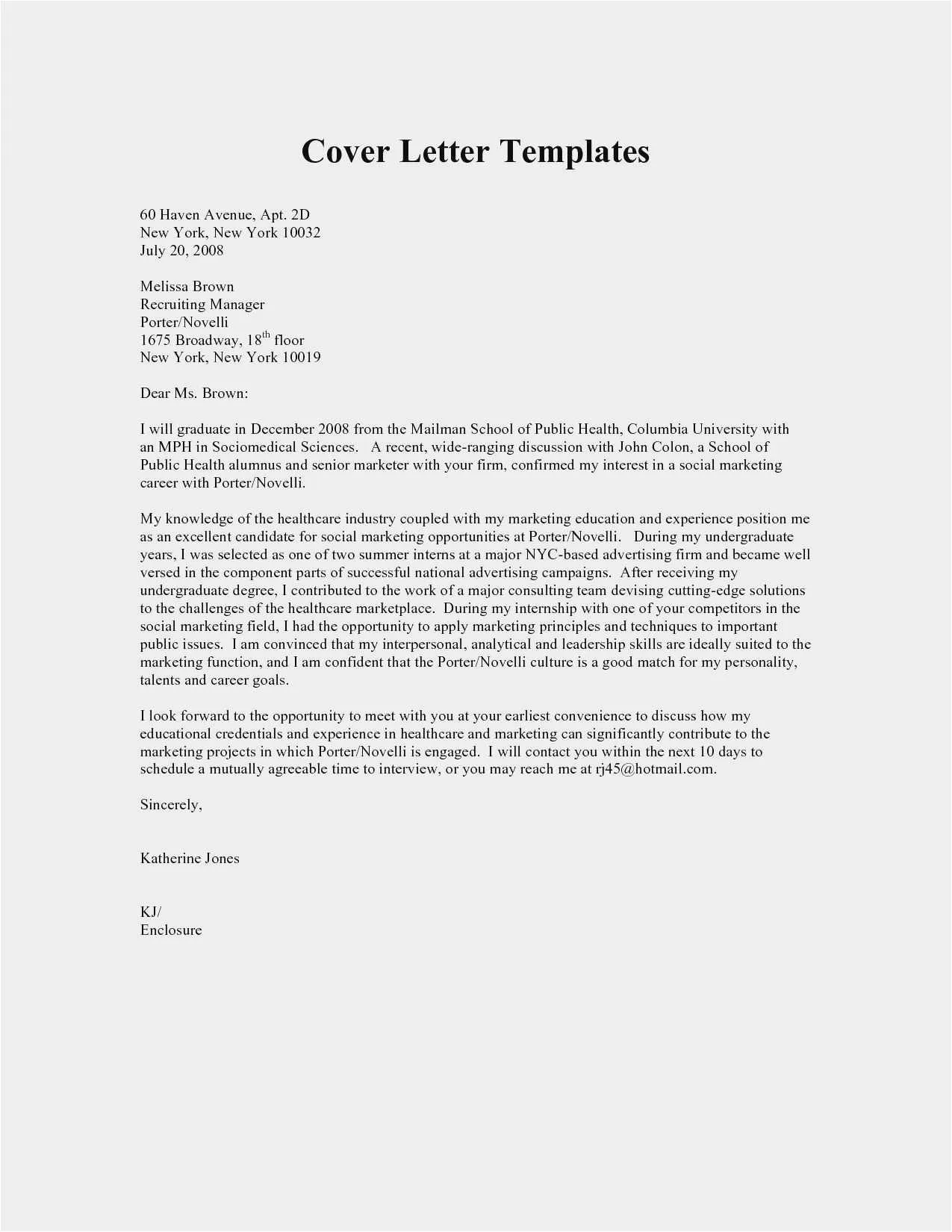Understanding the Power of a Teaching Job Cover Letter
In the competitive field of education, a well-crafted teaching job cover letter is your first opportunity to make a lasting impression. More than just a formality, it’s a powerful tool that can set you apart from other applicants and significantly increase your chances of landing an interview. Your cover letter provides a platform to showcase your personality, passion for teaching, and unique qualifications in a way that a resume alone cannot. It’s your chance to tell a story, explain your career goals, and demonstrate why you’re the perfect fit for a specific teaching role. By strategically using this document, you can transform a simple application into a compelling narrative that highlights your suitability and enthusiasm for the position.
What is a Teaching Job Cover Letter and Why Is It Important?
A teaching job cover letter is a personalized document that accompanies your resume, introducing you to a potential employer and providing context to your qualifications and experience. It’s essentially a professional introduction, designed to capture the hiring manager’s attention and encourage them to delve deeper into your application. This document is important because it is often the first piece of communication a hiring manager sees, giving you an immediate opportunity to make a positive impression. It allows you to demonstrate your communication skills, highlight relevant experience, and explain how your values align with the school’s mission. Properly formatted and thoughtfully written, it is essential for providing detailed insights that a resume cannot, thereby making you stand out in a crowded field of applicants.
Key Elements of a Successful Teaching Job Cover Letter
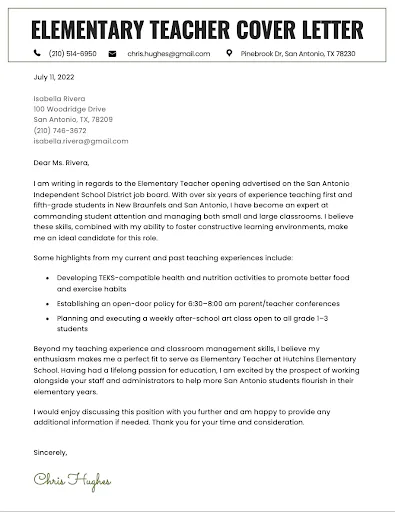
Creating a standout teaching cover letter involves mastering several key elements, each contributing to your overall presentation. These components work in synergy to demonstrate your professionalism, skills, and genuine interest in the position. From a well-structured header to a compelling closing, each part serves a specific purpose. Focusing on these elements ensures that your letter is not just informative, but also engaging and memorable to the hiring manager, who often reviews dozens of applications. A detailed and carefully constructed cover letter increases the chances of the recipient wanting to learn more about you.
Header and Contact Information
Start your cover letter with a professional header that includes your full name, address, phone number, and email address. Ensure that this information is accurate and easy to read. Following this, add the date and the recipient’s contact information, including their name and title, if known, and the school or district’s address. This section sets the tone, demonstrating your attention to detail and professionalism.
Addressing the Hiring Manager
Always address the hiring manager by name. If you are unsure, research the school’s website or call to find the correct person. Addressing the cover letter to a specific individual shows that you’ve done your homework and are genuinely interested in the position, which is more personable than using generic greetings like “To Whom It May Concern.”
Opening Paragraph: Grab Their Attention
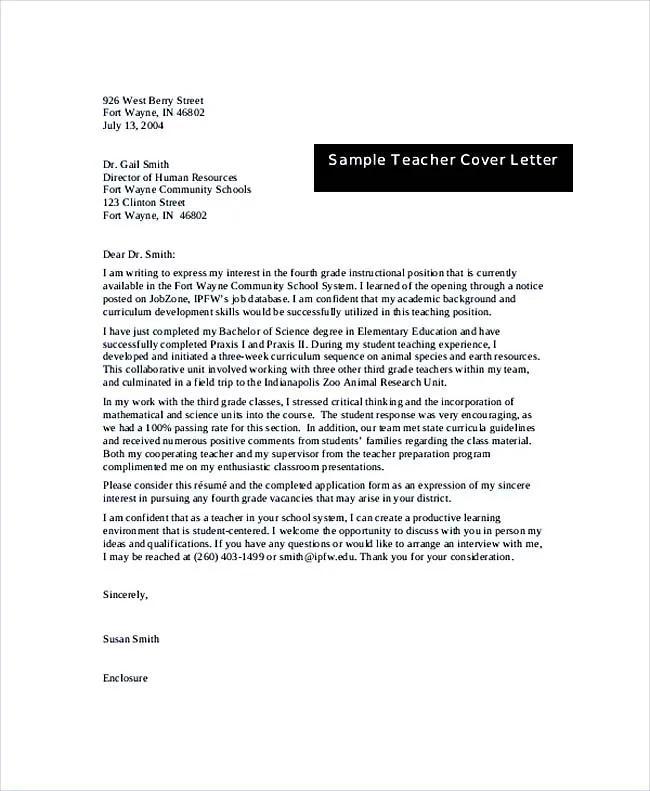
The opening paragraph is your hook. Begin with a strong statement that immediately captures the reader’s interest. This could be a brief introduction, expressing your enthusiasm for the role and the school, or a statement about why you are the perfect fit. It’s important to showcase your personality and highlight a key achievement or relevant experience. Briefly mention the specific position you’re applying for to provide immediate context.
Highlighting Your Qualifications and Experience
In the body paragraphs, elaborate on your qualifications and experience, emphasizing how they align with the job description. Select 2-3 of your most relevant skills and accomplishments, providing specific examples and evidence to support your claims. Quantify your achievements whenever possible. Make sure you clearly and concisely express your teaching philosophy, and mention any unique skills or experiences that set you apart.
Showcasing Your Achievements and Impact
Instead of just listing your responsibilities, focus on your achievements and the impact you’ve made in previous roles. Use the STAR method (Situation, Task, Action, Result) to describe specific situations and the positive outcomes of your actions. Provide concrete examples of how you’ve improved student performance, implemented innovative teaching methods, or contributed to the school community. Use these examples to demonstrate the benefits of hiring you.
Quantifiable Results and Data

Whenever possible, include quantifiable results to demonstrate your success. Use metrics to illustrate your impact, such as the percentage increase in student test scores, the number of students involved in a project you led, or the reduction in disciplinary incidents. Data-driven examples add credibility and clearly show your value. This is a great way to make sure that your experience is undeniable and adds weight to your application.
Tailoring Your Cover Letter to the Specific Job
Customize your cover letter for each teaching position. Avoid using a generic template; instead, carefully review the job description and tailor your letter to the specific requirements and qualifications. Highlight the skills and experiences most relevant to the role, and use keywords from the job posting to demonstrate that you meet their needs. Make sure the school knows you’re interested in their specific needs.
Researching the School and Its Values
Research the school and its values. Understand their mission, vision, and any specific programs they offer. Reference these aspects in your cover letter to demonstrate that you are a good fit for the school culture. This shows initiative and a genuine interest in joining their community. Highlight how your values align with the school’s principles.
Matching Your Skills to the Job Description
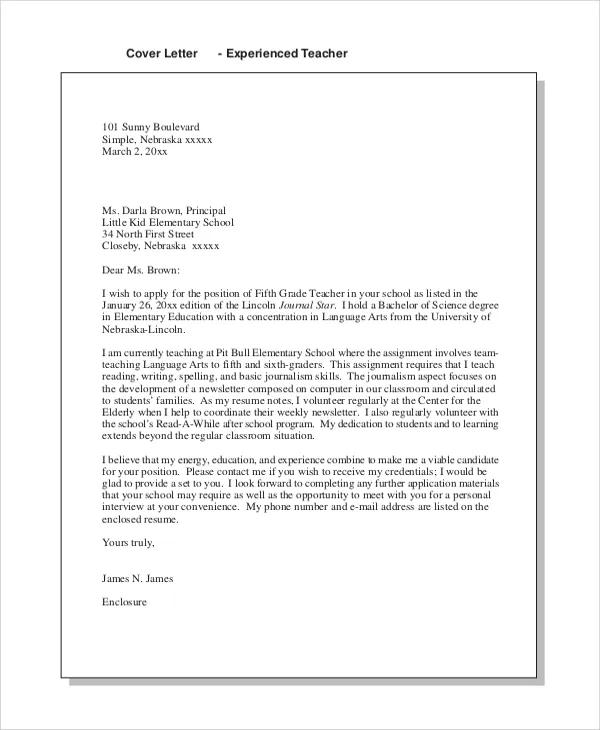
Carefully align your skills with the job description. Identify the key skills and qualifications the school is looking for and provide specific examples of how you possess these skills. Use the same language as the job description where appropriate to show that you understand the requirements and are well-suited for the position. Doing this makes it much more likely that your application will be read carefully.
Including Relevant Keywords
Incorporate relevant keywords from the job description throughout your cover letter. Many schools use Applicant Tracking Systems (ATS) to screen applications, so including these keywords ensures your application gets noticed. Focus on the key terms that describe the necessary skills, qualifications, and experience. Make sure to use them naturally and in context.
Writing a Compelling Closing Paragraph
The closing paragraph should reiterate your interest in the position and express gratitude for the reader’s time and consideration. Reiterate your enthusiasm and summarize your key qualifications, then clearly state your availability for an interview and how you can be contacted. It’s important to create a memorable and professional closing that encourages the reader to take action.
Expressing Your Enthusiasm and Desire
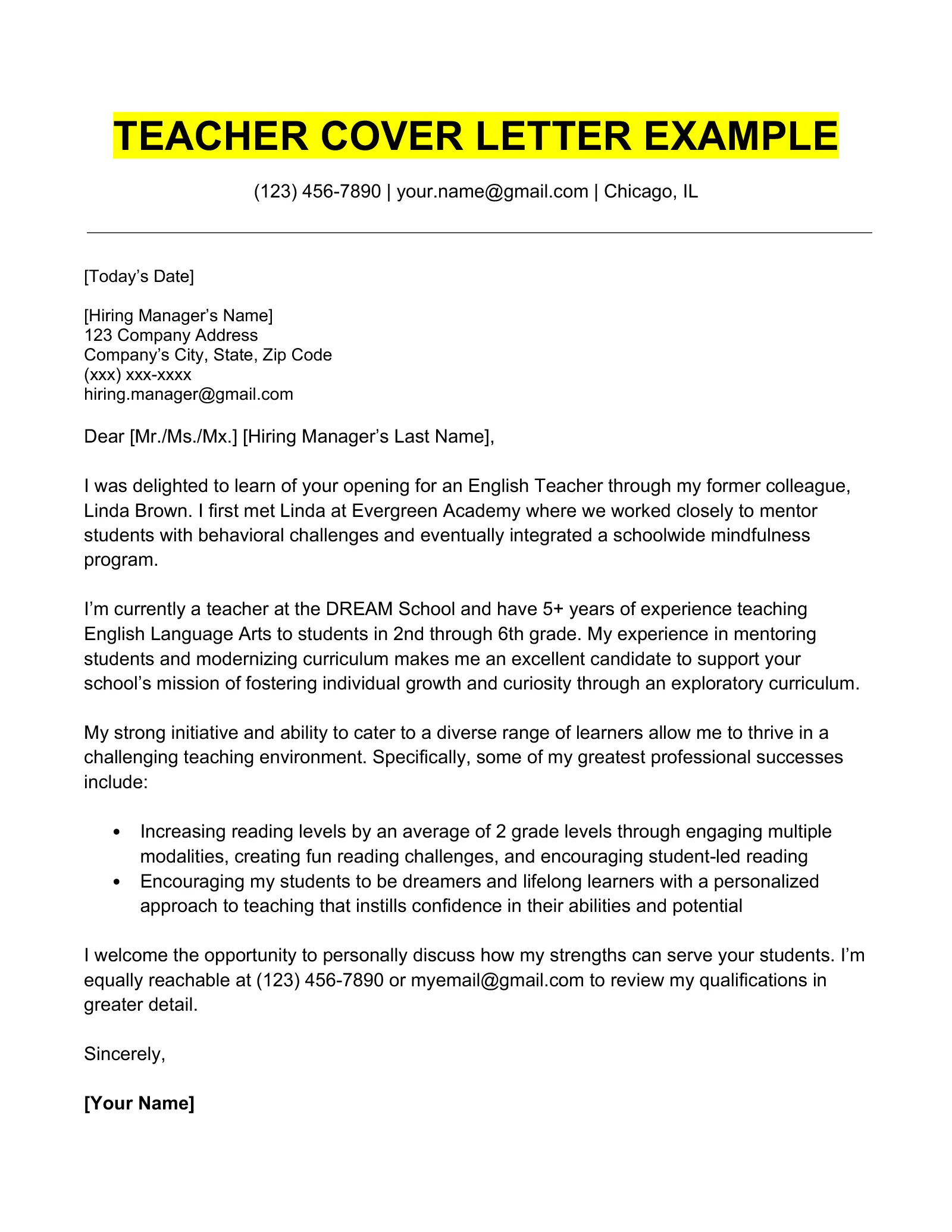
Express genuine enthusiasm for the teaching position and the school. Clearly articulate why you are excited about the opportunity and what you hope to achieve. Demonstrate your passion for education and your commitment to helping students succeed. Your enthusiasm should shine through and set you apart from other candidates.
Call to Action: Next Steps
Include a clear call to action in your closing paragraph. State your availability for an interview and how the hiring manager can contact you. Make it easy for them to take the next step by providing your contact information again. This helps the reader take action and keeps the application process moving forward smoothly.
Proofreading and Editing for Perfection
Before submitting your cover letter, carefully proofread and edit it for any errors. Errors can undermine your credibility and make you look unprofessional. Check for spelling, grammar, and punctuation mistakes. Ask a friend or colleague to review your letter for a fresh perspective. A polished and error-free cover letter demonstrates your attention to detail and professionalism, setting a positive tone with the reader.
Common Mistakes to Avoid in Your Teaching Cover Letter
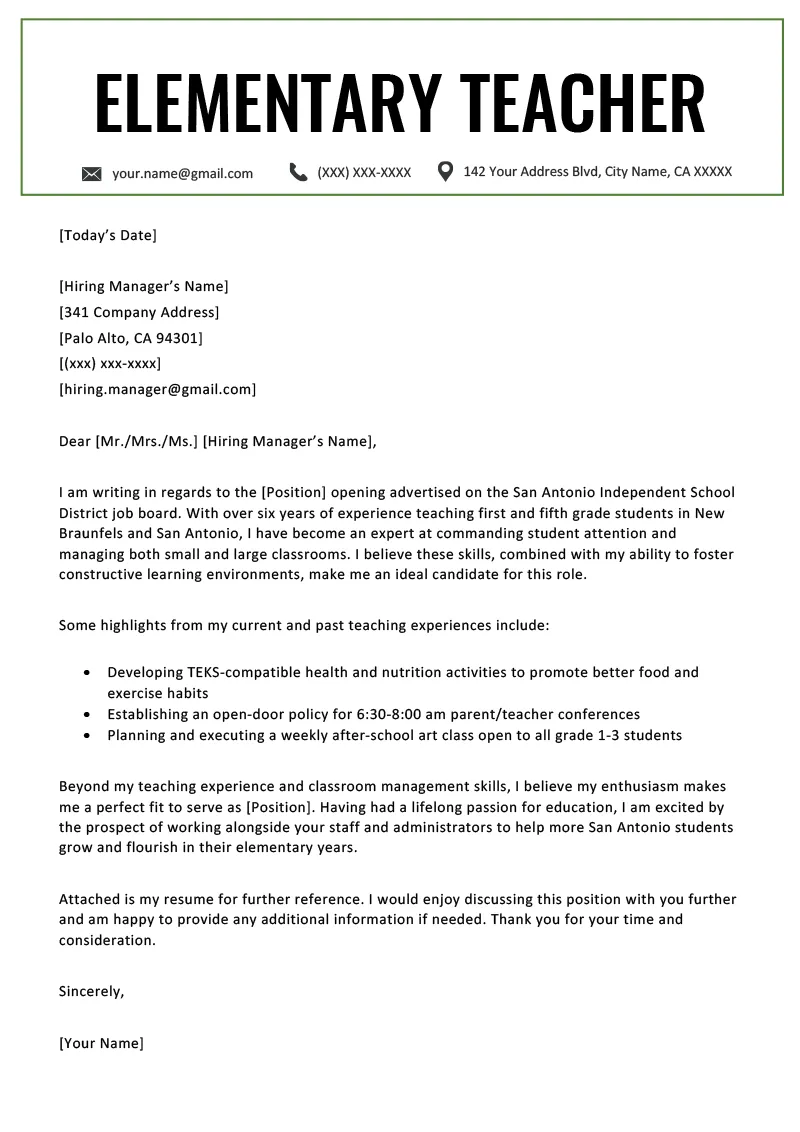
Avoiding common mistakes can greatly improve the effectiveness of your cover letter. These mistakes can range from grammatical errors to content that is not tailored to the specific job. Recognizing and rectifying these issues will increase your chances of success. The following are some common issues that applicants should avoid, ensuring their application is professional and effective.
Grammatical Errors and Typos
Carelessly written letters with spelling and grammatical errors can create a negative impression. Always proofread your cover letter thoroughly before submitting it. Use spell-check tools and have someone else review your letter to catch any mistakes you might have missed. A polished cover letter reflects your professionalism and attention to detail.
Generic and Uninspired Content
Avoid using generic content that can be applied to any job. Instead, tailor your letter to the specific teaching position and school. Highlight your unique skills and experiences that align with their needs. Show that you have done your research, and demonstrate that you’re genuinely interested in the position. Tailoring your cover letter for each application shows that you’re taking the time to care about the role.
Too Much Focus on Yourself
While you should highlight your qualifications, don’t make your cover letter all about yourself. Instead, focus on how you can contribute to the school and its students. Demonstrate your understanding of the school’s values and mission, and explain how your skills and experience will benefit their community. Show how you can make a positive impact, rather than just listing your achievements.
Example Teaching Job Cover Letter
Here is an example of a well-structured cover letter. This structure is a good base, however, remember to tailor it to your own experience and the requirements of the specific job. Ensure that you customize this example according to your qualifications and the job requirements. Remember to also check for all errors before sending your application.
Example Paragraphs for Different Teaching Positions
Adaptable examples are very useful when it comes to tailoring to your specific requirements. Below, you will find example paragraphs, each tailored for different teaching roles. Customize these examples with your own details and ensure they match the requirements listed in the job description. This will show the hiring manager that you have read the details of the job, are interested in the position, and meet the qualifications.
Elementary School Teacher
“As a dedicated elementary school teacher with five years of experience, I am excited about the opportunity to join [School Name]. My passion for creating engaging and inclusive learning environments has led to consistently positive results in my classroom. For example, I implemented a project-based learning curriculum that increased student engagement by 30%. I am particularly drawn to [School Name]’s commitment to fostering creativity and critical thinking skills, which aligns perfectly with my teaching philosophy.”
High School Teacher
“I am writing to express my strong interest in the High School Teacher position at [School Name]. My expertise in [Subject Area] and my ability to cultivate a stimulating learning environment for high school students make me a perfect fit for your requirements. During my time at [Previous School], I developed and implemented a new curriculum that improved student performance by 25% on standardized tests. I am particularly impressed by [School Name]’s focus on [School value or program] and believe I can contribute to your educational goals.”
Special Education Teacher
“I am enthusiastic about the Special Education Teacher position at [School Name]. My experience working with students with diverse learning needs, combined with my passion for inclusive education, makes me a strong candidate. At [Previous School], I developed individualized education plans (IEPs) for students with various disabilities. By implementing these plans, I was able to improve student progress by an average of 40%. I admire [School Name]’s dedication to supporting every student, and I am keen to contribute my skills to your inclusive community.”
